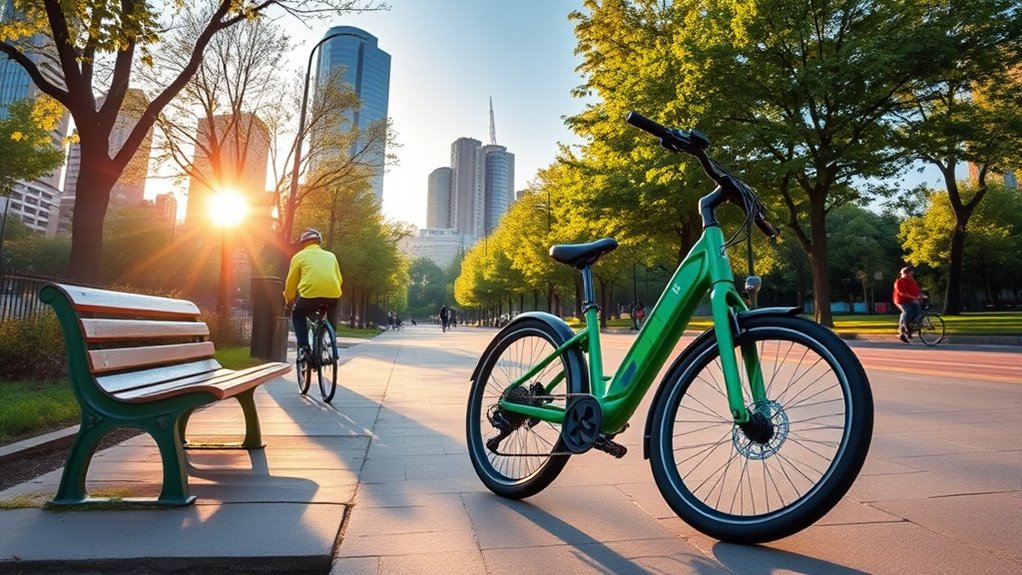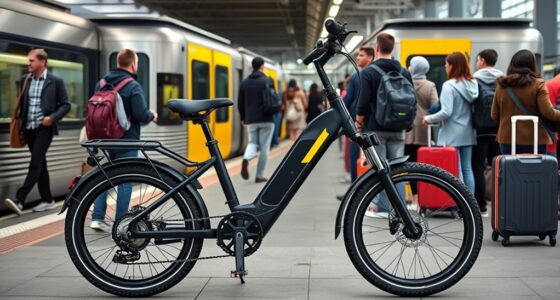Using a commuter e-bike helps you substantially reduce your carbon footprint because it’s energy-efficient and produces far fewer emissions than cars. It consumes less energy, requires no fossil fuels, and helps ease urban congestion, which lowers vehicle emissions. Plus, it encourages physical activity and saves you money on fuel and maintenance. By choosing e-bikes, you’re supporting a greener future—discover how this simple switch can make a big impact on our environment.
Key Takeaways
- E-bikes consume less energy than traditional vehicles, significantly lowering overall carbon emissions during daily commutes.
- They help reduce urban traffic congestion, leading to decreased vehicle idling and associated emissions.
- Using e-bikes diminishes reliance on fossil fuels, supporting cleaner air and a smaller carbon footprint.
- E-bikes promote active transportation, encouraging more eco-friendly travel habits in cities.
- Their energy efficiency and low maintenance requirements make them a sustainable, green alternative for urban commuting.

Electric bikes, or e-bikes, have become a popular alternative to traditional transportation, offering a greener way to get around. They combine the benefits of cycling with the convenience of electric power, making daily commutes more efficient and less stressful. One of the key advantages of e-bikes is their electric efficiency. Unlike cars that rely solely on gasoline or diesel, e-bikes use a small electric motor powered by batteries, which consume substantially less energy. This means you get to travel longer distances while expending less energy, reducing your overall carbon footprint. As a result, e-bikes help decrease reliance on fossil fuels, contributing to cleaner air and a healthier environment.
E-bikes use less energy than cars, reducing your carbon footprint and supporting a cleaner environment.
When you choose an e-bike for your daily commute, you actively reduce urban congestion. Traffic jams are a common headache in cities, and they also lead to increased emissions from idling vehicles. E-bikes take up less space on the road and can often weave through traffic more easily than cars. This not only speeds up your travel time but also helps ease the pressure on city infrastructure. Because you’re not stuck in traffic, you’re contributing to less vehicle emissions, which are among the leading causes of air pollution and climate change. E-bikes can also make city riding safer and more comfortable, encouraging more people to ditch their cars and opt for a cleaner, more sustainable mode of transport.
Moreover, e-bikes support a healthier lifestyle. They allow you to incorporate physical activity into your routine without the exhaustion that often accompanies traditional biking. This balance encourages more frequent use, which amplifies their positive environmental impact. Additionally, e-bikes are cost-effective. They require less maintenance than cars and trucks and don’t depend on expensive fuel, making them an economically sound choice for many commuters. Over time, the savings on fuel, parking, and maintenance can be substantial, further incentivizing their use.
As cities continue to grow and face transportation challenges, e-bikes stand out as a practical solution to reduce carbon emissions and improve urban life. Their electric efficiency means you do more with less energy, and their ability to alleviate urban congestion benefits everyone. By making the switch to an e-bike, you’re not just simplifying your commute—you’re actively participating in a movement toward a more sustainable future. With each ride, you help lower your personal carbon footprint while enjoying the convenience, cost savings, and health benefits that come with this innovative mode of transportation.
Frequently Asked Questions
How Long Do Commuter E‑Bike Batteries Typically Last?
You might wonder how long your commuter e-bike’s battery lasts. Typically, a battery lifespan ranges from 3 to 5 years, depending on usage and maintenance. It usually endures around 500 to 1,000 charging cycles before its capacity starts to decline. To maximize your battery’s longevity, avoid frequent deep discharges and keep it charged between 20% and 80%. Proper care guarantees your e-bike remains reliable for daily commuting.
Are E‑Bikes Suitable for All Weather Conditions?
Like a sturdy ship in rough seas, e‑bikes can handle various weather conditions, but their weather resilience varies. They perform well in most seasons, yet rain, snow, or mud pose seasonal challenges. You should consider weatherproof features and tires designed for wet or icy surfaces. While they’re versatile, extreme weather might limit your riding, so plan accordingly to stay safe and comfortable regardless of the forecast.
What Maintenance Is Required for E‑Bikes?
You’ll want to keep your e-bike in top shape with regular maintenance. Focus on battery longevity by avoiding extreme temperatures and charging it properly. Tire maintenance is also key—check air pressure regularly and look for wear or punctures. Keeping these in mind helps your e-bike perform smoothly, extends its lifespan, and guarantees you get the most out of your ride every time you hit the road.
How Do E‑Bikes Compare in Cost to Traditional Bikes?
Oh, the thrill of comparing costs! You’ll find e‑bikes are pricier upfront than traditional bikes, but don’t let that scare you. With cost comparison, you’ll notice long-term savings on fuel, maintenance, and parking. Plus, the extra boost means less effort and more fun. In the end, investing in an e‑bike pays off through reduced expenses and a greener, healthier commute. Who knew savings could be this exciting?
Can E‑Bikes Be Used on Bike-Sharing Programs?
You can definitely use e-bikes in bike-sharing programs, as many cities are integrating them into urban mobility solutions. Bike sharing integration with e-bikes offers a convenient, eco-friendly way to navigate busy streets and reduce car reliance. These programs make e-bikes accessible to everyone, promoting sustainable transportation options and helping you enjoy the benefits of electric-assisted riding without owning one. It’s a smart move for urban commuting.
Conclusion
By choosing an e-bike, you’re planting a seed for a greener future, turning your daily commute into a river of change. Each pedal stroke shrinks your carbon footprint like a drop in the ocean, yet together, those drops create waves of impact. Embrace the ride, and you’ll not only travel farther but also help to clear the skies, making your journey a gust of fresh air for the planet. Your greener commute starts now—ride toward a cleaner Earth.









